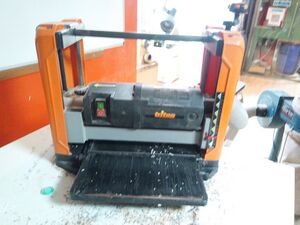Triton Thickness Planer
A thickness planer used to get 2 surfaces of a board parallel and then reduce them to a controlled thickness
| Thickness Planer (Triton) | |
|---|---|
 | |
| Model | Unknown |
| Sub-category | Woodworking |
| Status | Good working order |
| Last updated | 24 March 2025 15:34:31 |
| Training requirement | yes |
| ACnode | no |
| Location | Wood shop |
| Maintainers | Woodshop team |
Training is required
Often used in conjunction with the surface planer which makes the initial flat surface on one face of the board
The mechanism has a tendancy to jam if used without chip extraction, for which the portable portable dust extractor should be used
Do not attempt to plane end grain (e.g. glued up cutting board) in this machine, they are very likely to break and fire back out of the machine
Do not attempt to plane short workpieces (less than around 250mm long) - they will be unsupported by the feed rollers during the middle of the cut so will spin and jam inside the machine
Risk Assessment - Wood Planers
This risk assessment is intended to provide guidance on the risk associated with the above equipment and activities in normal use. Please also check general risk assessments for the space as a whole. Any discrepancies, errors or concerns should be raised with the document maintainers or trustees - do not edit this assessment directly. For responsible persons and last update, see 'version log' of the assessment page.
Activity
Use of handheld or stationary wood planing equipment such as handheld planers, bench planers (aka jointers) or thickness planers
Signage
Understanding Risk Rating
LOW - Ensure current control measures are in place and continue with activity
MED - Control measures may be adequate, co-supervision is recommended
HIGH - Do not undertake activity without further consultation with area specialists
Risk Assessment
| Identify Hazards | Who May be Harmed and How | Severity | Control Measures | Likelihood | Risk Rating |
|---|---|---|---|---|---|
| Incompetent user | User, bystander | HIGH | Members must not use tools that they are not competent to use. Members must challenge use that they believe is dangerous. Members must read the user manual for this tool. Members must read the risk assessment before using a tool. Members will be advised during induction which tools they will need supervision or an induction to use. Only authorised members will complete maintenance and calibration tasks. | LOW | MED |
| Contact with rotary knives | User | HIGH | Do not put hands within 10cm of blade. Do not push workpiece over blade with hands. Use a push block to push workpiece over cutting area. Use guard to cover unused cutting area. Use guard to cover entire cutting area when thicknesser is being used. Do not insert hands into thicknesser when machine is plugged in. Planer should be turned off immediately after use. | MEDIUM | MED |
| Drawing in (being pulled into the drum) | User | HIGH | User of the thicknesser/planer should not wear gloves, ties, scarves, or other long flowy clothing that could get pulled into the blade. Do not move hands past the blade. Do not use the machine on short stock. | LOW | MED |
| Dust (inhalation, fire, explosion) | User, bystander | MEDIUM | Stationary machines must be used with the workshop dust extractor. An extraction hose must be attached to the machine’s extraction hood, which must be positioned appropriately for use with the thicknesser or planer. Maintenance must include the cleaning of dust from within the unit housing where accessible. Check the extraction hood periodically for blockages. A respirator or mask should be used whilst operating this tool for prolonged periods. | LOW | LOW |
| Noise | User, bystander | MEDIUM | Ear protection is advised. | LOW | LOW |
| Flying splinters | User, bystander | HIGH | Eye protection must be worn In the workshop. Only cut wood, ensuring the workpiece is free from nails, screws or other objects. | LOW | MED |
| Lifting heavy object | User | MEDIUM | The machine must be lifted into a stable position on the working area using correct manual handling procedures. | LOW | LOW |
| Electrocution | User, bystander | HIGH | Do not use if any damage to plug, cables, or machine. | LOW | MED |